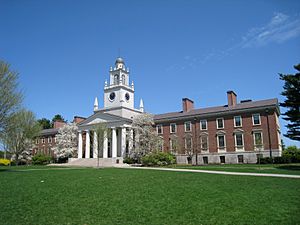College-preparatory school facts for kids
A college-preparatory school (often called a prep school) is a type of secondary school. These schools are mainly designed to help students get ready for higher education, like college or university. They can be public, private, or religious schools.
Contents
Prep Schools in Japan
In Japan, college-prep schools are known as Shingakukō (進学校). This name means a school that helps you move on to the next level of education. Prep schools in Japan are often seen as important and can be hard to get into.
There are different levels of prep schools. The level depends on which university the school aims to prepare students for. Many Japanese prep schools are six-year schools. They often started as older types of secondary schools for boys or girls.
Students who want to attend a prep school in Japan usually take written exams. These exams are taken in the sixth grade for each specific prep school. Some top public high schools, which are three-year schools, are also considered Shingakukō.
The Japanese government helps private schools with money. This means that tuition for private prep schools is usually around $5,000 to $10,000 each year.
Prep Schools in the United States
In the United States, college-prep schools can be public, private, or charter schools. They might be religious or non-religious. Some schools choose students based on their grades or other skills. Other schools accept all students who apply.
In 2017, about 5.7 million students were in private elementary or secondary schools in the US. This was about 10% of all students. Around 1.4 million of these students were in non-religious private schools.
Public and Charter Prep Schools
Public and charter college-prep schools are usually part of a local school district. They often accept students from the whole district, not just the closest neighborhoods. Some of these schools offer special classes or programs. These programs might prepare students for a certain field of study. Other schools use the "college-prep" name for promotion. They might not offer different programs than a regular high school.
History of US Prep Schools
Prep schools started in the US before the American Civil War. At that time, there were no public schools beyond elementary level. Students were not ready for college after elementary school. So, many colleges created "preparatory academies" to get students ready.
Some of these prep schools were not connected to colleges. This was especially true for girls' schools. Back then, boys and girls did not study together. There were no women's colleges either. Some of these girls' prep schools later became women's colleges after the Civil War.
Free high school education became available to everyone in the late 1800s and early 1900s. Since then, most "prep schools" in the US are private. These schools are often very selective about who they admit. They also have high tuition fees. They serve students usually between 13 and 18 years old.
Types of Private Prep Schools
Private prep schools can be day schools, where students go home each day. They can also be boarding schools, where students live at the school. Some schools are both. They can also be co-educational (boys and girls together) or single-sex (only boys or only girls).
Today, day schools are more common than boarding schools. Since the 1970s, co-educational schools have become more common than single-sex schools. Unlike public schools, which are free, private prep schools charge tuition. In 2014, this could be $10,000 to over $40,000 per year.
Some prep schools are linked to a specific religion. However, independent prep schools are not controlled by a religious group. Students usually do not have to learn about one specific religion. These independent schools are not directly watched by the government. But many are approved by special groups called regional accreditation agencies.
See also


